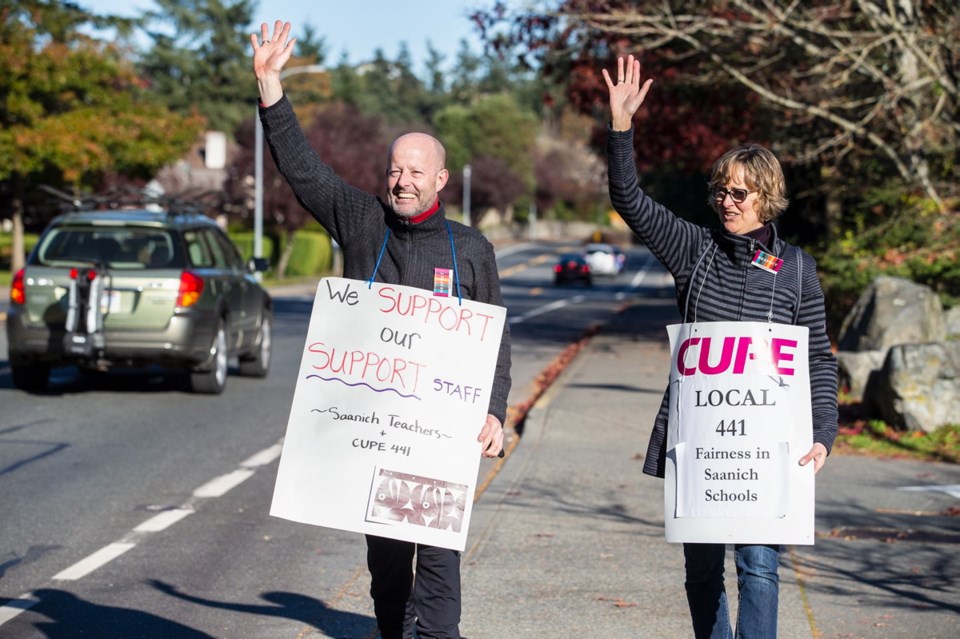With a support-workers strike in the Saanich School District likely to keep schools closed for a third day today, parents are continuing to do what they can to keep their children occupied and cared for.
James Taylor of the Confederation of Parents’ Advisory Councils of Saanich said he has been in contact with parents across the district and is hearing a range of stories from parents. Some are stay-at-home parents or have had time off work and haven’t been affected, while others have had help from unusual sources.
“A local soccer coach has been holding free practices on a local field for half days,” he said. “There is another anecdote of a Grade 6 student who took on a Grade 1 student and is planning a curriculum and field trips, kind of a mentoring thing.”
Taylor said the outlook will be different if the strike goes on for more than a few days, yet he doesn’t see a resolution coming this week. “People said that they could probably weather a week, but once we hit that week stage, people’s resources are going to be tapped out,” he said.
“I really feel for everyone and I’m really concerned that if this drags on, it’s going to take a toll.”
Members of the Canadian Union of Public Employees Local 441 have been picketing since Monday after not being able to reach a deal with the Saanich School District. The Saanich Teachers’ Association is honouring the picket line.
About 500 CUPE 441 members in the school district, including education assistants, counsellors and clerical workers, are involved in the job action, which affects close to 8,000 students.
One of the primary issues is achieving wage parity with neighbouring school districts. The union says an education assistant, for example, is paid $21.61 per hour under the last contract in the Saanich district, while a similar worker in the Sooke district makes $25.28, and one in the Greater Victoria district is paid $25.20 an hour.
Taylor said the parents he has talked to are largely sympathetic to the strikers. “They’re understanding what the union’s saying in terms of the wage parity.”
Taylor said he has also heard from parents of special-needs students about the challenges they are having with the cost of care. “Somebody threw the number out that to get care for their child is $25 an hour.”
Meanwhile, parents of high-school students are worrying about the potential impact of long-term job action, Taylor said.
“For kids in Grade 11 and Grade 12, they’re focusing on what they’re going to do after high school, and because high school’s on a semester system, missing one day is actually compounded,” he said. “It’s more like missing two days.
“There’s a lot of frustration and anxiety that this could really put them behind the eight ball in terms of trying to catch up on their course work.”
Education Minister Rob Fleming, under questioning on Tuesday in the legislature from Adam Olsen, MLA for Saanich North and the Islands, said the situation in the Saanich School District is “very stressful” for parents and children. He said the ministry is monitoring it closely and will give any assistance it can.
The school district has said it has put the maximum amount of money on the table that it is legally allowed to, under its mandate from the province.
“We continue to provide an opportunity for the union to come back to the bargaining table to continue negotiations with us,” said district superintendent Dave Eberwein. “The challenge … is the definitive bargaining mandate that we’re obligated to follow — that both sides are obligated to follow.”
The superintendent said he hopes the union will be able to come back to the table “to negotiate some of the finer points around what offer the employer has put out there.”
“Right now, I know our support staff would like to be in their jobs at work. I know teachers would like to be in their classrooms, all of us in the school district offices and schools would like school to be in session at this time,” Eberwein said. “It is very disappointing.”
Olsen said the contract impasse might not be solvable locally because of the inflexibility of the provincial framework being used.
It’s up to Fleming to solve the situation, he said. “The situation is on this government.”
In April 2000, CUPE members were legislated back to work after they walked off the job and kept 370,000 students out of school for five days. In a bid to resolve the dispute, then premier Ujjal Dosanjh sent the workers back into the schools and appointed two industrial inquiry commissioners to impose a binding settlement if school boards failed to reach deals with their unions.
— With files from Cindy E. Harnett



